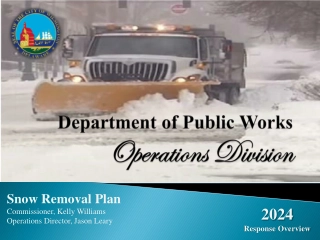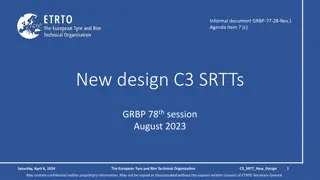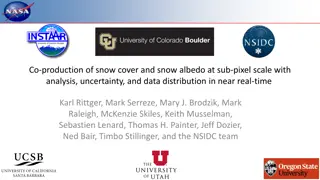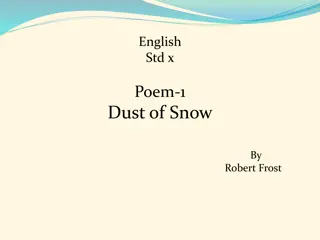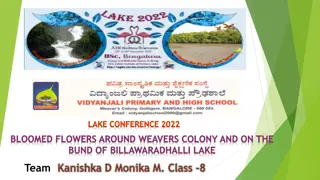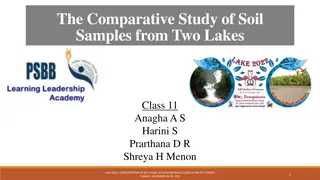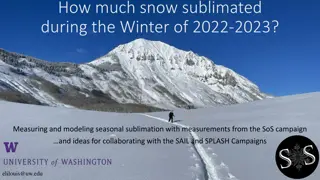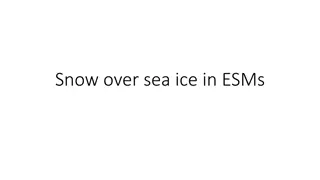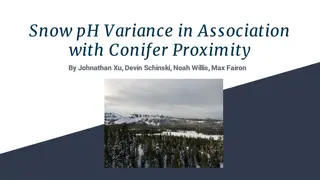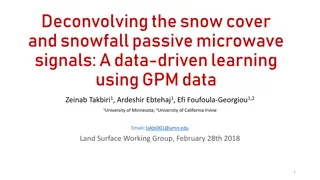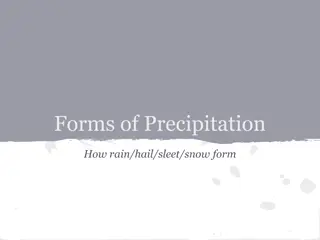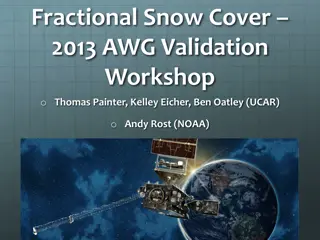Improving GMI Lake Effect Snow Retrievals
GPM Microwave Imager provides enhancements to the GPROF operational algorithm for accurate lake-effect snow quantitative precipitation estimates. The study evaluates observational analysis, precipitation retrieval improvements, and the significance of accurate snowfall quantification for emergency management.
Download Presentation

Please find below an Image/Link to download the presentation.
The content on the website is provided AS IS for your information and personal use only. It may not be sold, licensed, or shared on other websites without obtaining consent from the author.If you encounter any issues during the download, it is possible that the publisher has removed the file from their server.
You are allowed to download the files provided on this website for personal or commercial use, subject to the condition that they are used lawfully. All files are the property of their respective owners.
The content on the website is provided AS IS for your information and personal use only. It may not be sold, licensed, or shared on other websites without obtaining consent from the author.
E N D
Presentation Transcript
Analysis of GPM Microwave Imager Lake Effect Snow Retrievals Provides Improvements to the GPROF Operational Algorithm Lisa Milani (Code 612, NASA/GSFC and UMD); M.S. Kulie (NOAA); D. Casella (ISAC-CNR); P.E. Kirstetter (NOAA); G. Panegrossi (ISAC-CNR); V. Petkovic (UMD); S.E. Ringerud (Code 612, NASA/GSFC and UMD; J-F. Rysman; P. San (ISAC-CNR); N-Y. Wang (NOAA); Y. You (UMD); G. Skofronick-Jackson (NASA/HQ) Quantitative precipitation estimates (QPE) of extreme lake-effect snow events are a big challenge for passive microwave remote sensing. The GPM Microwave Imager (GMI) high frequency channels can clearly detect intense shallow convective snowfall events over the United States lower Great Lakes region. However, GMI Goddard PROfiling (GPROF) QPE retrievals produce inconsistent results when compared against the Multi-Radar/Multi-Sensor ground-based radar reference dataset. More accurate surface classification and better representativeness of the GPROF a priori databases would represent an important step for improving lake-effect snow QPE.
Name: Lisa Milani, NASA/GSFC, Code 612 and UMD E-mail: lisa.milani@nasa.gov Phone: 301-614-5703 References: Milani, L., et al. (2020). Extreme lake-effect snow from a GPM microwave imager perspective: Observational analysis and precipitation retrieval evaluation. Journal of Atmospheric and Oceanic Technology, doi: 10.1175/jtech-d-20-0064.1. Data Sources: For performing this study, the 1C-R-GMI product (TBs) and the 2AGPROFGMI (precipitation rates and environmental information) have been used. These datasets are freely available through the (https://storm.pps.eosdis.nasa.gov/storm/). MRMS dataset is available online from the NASA Global Hydrology Center DAAC, Huntsville, Alabama, U.S.A. doi: http://dx.doi.org/10.5067/GPMGV/MRMS/DATA101 as cited by Kirstetter et al 2018. Snow depth and snowpack temperatures are available from the National Weather Service Snow Analysis at https://www.nohrsc.noaa.gov/nsa/ and the Lake Effect Snow Event Archive is available online at https://www.weather.gov/buf/lesEventArchive?season=2017-2018&event=A. Radiosondes data of National Weather Service Weather Forecast Office are available from the University of Wyoming College of Engineering website (http://weather.uwyo.edu/upperair/sounding.html) and the surface temperature analyses from NOAA Great Lakes Environmental Research Laboratory website (https://coastwatch.glerl.noaa.gov/glsea/glsea.html). NASA Precipitation Processing System (PPS) data archive Technical Description of Figures: Graphic: GPM orbit #4914 detecting and quantifying a lake effect snow event at 1226 UTC 9 January 2015 over Lakes Erie and Ontario. MRMS-GV snowfall rate (left), GPROF precipitation rate using SurfPrecip parameter from the standard product (center), and GPROF precipitation rate with ad hoc threshold and coastal application of snow-cover a priori database (right). The standard GPROF product does not detect the intense snow band and overproduces light snowfall rates over snow-covered regions, while the modified retrievals reproduce the observed MRMS snowfall rate more closely. Scientific significance, societal relevance, and relationships to future missions: Lake-effect snow events have the potential to produce massive quantities of snow, severely impacting travel and commerce. Given the value of space-based observations of precipitation, especially in orographically complex regions, accurate quantification of snowfall is vital for local emergency management officials to ensure public safety; however, the shallow nature of these events and poorly characterized surface backgrounds present particular challenges for spaceborne precipitation sensors. This study focuses on the ability of the Global Precipitation Measurement (GPM) passive microwave sensors to detect and quantify extreme lake-effect snowfall events over the United States lower Great Lakes region. GPM Microwave Imager (GMI) high frequency channels can clearly detect intense shallow convective snowfall events. However, the GMI Goddard PROfiling (GPROF) retrievals produce inconsistent results when compared against the Multi-Radar/Multi-Sensor (MRMS) ground-based radar reference dataset. While GPROF retrievals adequately capture intense snowfall rates and spatial patterns of one event, GPROF systematically underestimates intense snowfall rates in another event. Furthermore, GPROF produces abundant light snowfall rates that do not conform with MRMS observations. Ad-hoc precipitation rate thresholds (PRT) are suggested to partially mitigate GPROF s overproduction of light snowfall rates. The sensitivity and retrieval efficiency of GPROF to key parameters (2-meter temperature, total precipitable water, and background surface type) used to constrain the GPROF a-priori retrieval database are investigated. Results demonstrate that typical lake-effect snow environmental and surface conditions, especially coastal surfaces, are underpopulated in the database, adversely affecting GPROF retrievals. Using a snow-cover a-priori database in the locations originally deemed coastline improves retrieval. This study suggests that it is particularly important to have more accurate GPROF surface classification and better representativeness of the a-priori databases to improve intense lake-effect snow detection and retrieval performance. The results of this work will be particularly useful for the Aerosols, Clouds, Convection, and Precipitation Decadal Survey concept that will pair relevant radiometer bands with radars much more suited for observing snowfall than the current generation of spaceborne cloud and precipitation radars. Earth Sciences Division - Atmospheres
Spectral Aerosol Absorption from DSCOVR EPIC A. Lyapustin, Code 613 NASA GSFC; S. Go, UMBC; Y. Wang, UMBC; S. Korkin, USRA We developed a new capability for simultaneous retrieval of aerosol optical depth (AOD) and spectral absorption of biomass burning smoke and mineral dust from DSCOVR EPIC observations in the UV-Visible part of spectrum. It is integrated in version 2 (v2) MAIAC EPIC atmospheric correction algorithm which recently completed re-processing of the EPIC 2015-2020 data record. Besides AOD, spectral surface reflectance and BRDF, v2 MAIAC reports at 10km resolution aerosol single scattering albedo (SSA) at 443nm, imaginary refractive index at 680nm (k0) and spectral absorption exponent (b) characterizing dependence k( ).
Name: Alexei Lyapustin, NASA/GSFC Code 613 E-mail: Alexei.I.Lyapustin@nasa.gov Phone: 301-614-5998 References: Lyapustin, A., S. Go, S. Korkin, Y. Wang, O. Torres, H. Jethva, A. Marshak: Retrievals of Aerosol Optical Depth and Spectral Absorption from DSCOVR EPIC, Frontiers Remote Sensing, in review, 2021. Lyapustin, A., Wang, Y., Korkin, S., and Huang, D.: MODIS Collection 6 MAIAC Algorithm, Atmos. Meas. Tech., 11, 5741-5765, https://doi.org/10.5194/amt-11-5741-2018, 2018. Torres, O., Ahn, C., & Chen, Z., Improvements to the OMI near-UV aerosol algorithm using A-train CALIOP and AIRS observations. Atmos. Meas. Tech., 6(11), 3257-3270, 2013. Schuster, G., O. Dubovik, and A. Arola (2016), Remote sensing of soot carbon Part 1: Distinguishing different absorbing aerosol species, Atmos. Chem. Phys., 16, 1565-1585, doi:10.5194/acp-16-1565-2016. Data Sources: v2 MAIAC EPIC products are currently being released; v1 MAIAC EPIC (https://doi.org/10.5067/EPIC/DSCOVR/L2_MAIAC.001), AERONET dataset (https://aeronet.gsfc.nasa.gov). Technical Description of Figures: Images: (Center) Illustration of v2 MAIAC EPIC retrievals for Saharan dust storms originating from Bodele depression (Jan. 1, 2018), Arabian peninsula (Mar. 29, 2018) and west Africa (May 29, 2018). The panels show EPIC top of atmosphere (TOA) RGB image, and unitless Aerosol Index (AI) from 340 and 388nm, aerosol optical depth (AOD1km) for effective height 1km, Single Scattering Albedo at 443nm (SSA443), spectral absorption exponent (b) and imaginary refractive index at 680nm (k0). (Right) AERONET-based validation of SSA443 for the wildfire smoke over North America in 2018 (top) and for mineral dust over greater Sahara region in 2018 (bottom). Validation for smoke/dust is presented for an effective aerosol layer height of 4km and 1km, respectively. Scientific significance, societal relevance, and relationships to future missions: Aerosol absorption has a high natural variability and is poorly constrained in models. This makes it one of the largest sources of uncertainty in assessments of aerosol direct radiative effects and in current climate projections [IPCC 2013]. Information on spectral dependence of aerosol absorption provides a pathway to the speciation of absorbing aerosol components [e.g., Schuster et al., 2016] information required in climate modeling and in Air Quality research. In v2 MAIAC EPIC algorithm, we developed a capability to simultaneously retrieve AOD and spectral aerosol absorption using the following model for spectral imaginary refractive index k = k0 ( / 0)-b, where 0 = 680nm. The Levenberg-Marquardt optimal minimization algorithm is used to find (AOD, b, k0) by matching EPIC observations at 340, 388, 443 and 680nm. An initial validation of single scattering albedo over North America and northern Africa in 2018 shows good agreement with AERONET, typically within the AERONET uncertainty of 0.03. Earth Sciences Division - Atmospheres
Calculating the Height of Volcanic Cloud SO2 With a Lagrangian Trajectory Tool: Raikoke (2019) and Pinatubo (1991) Cases. Gorkavyi, N., Krotkov, N., Li, C., Lait, L., Vasilkov, A., Colarco, P., Joiner, J., Schoeberl, M., Carn, S., Fisher, B. We developed a tool to reconstruct the altitude of SO2 clouds ejected by a volcanic eruption. We obtained a distribution of SO2 altitudes between 2 and 15 km in different parts of the SO2 clouds (a-b) from the Raikoke eruption in June 2019. For the June 15, 1991 Pinatubo eruption, we similarly obtained a wide distribution of SO2 heights from 10-25 km. To validate the plume heights we use independent sources of information such as the SNPP/OMPS Limb Profiler or CALIPSO/CALIOP lidar. a b H-solution for Raikoke Standard estimation SO2 with H=13 km: 1.19*106 tn; After recalculation of SO2 for the calculated distribution of heights: 1.40*106tn or 18% more. SO2 OMPS/NM Raikoke, June 22, 2019 0 1 2 5 10 25 50 100 150 SO2 (VCD) 50 75 100 150 200 250 300 350 400 H-solution for Pinatubo c SO2, TOMS d We found that the southern part of the Pinatubo plume is located in the troposphere, and the northern part is in the stratosphere. Pinatubo, June 17, 1991
Nick Gorkavyi (nick.gorkavyi@ssaihq.com) References: Gorkavyi, N., Krotkov, N., Li, C., Lait, L., Vasilkov, A., Colarco, P., Joiner, J., Schoeberl, M., Carn, S., Fisher, B. Calculating the Height of Volcanic Cloud SO2 With a Lagrangian Trajectory Tool: Raikoke (2019) and Pinatubo (1991) Cases (presentations for AGU-2020 and AMS-2021; paper in preparation) Data Sources: The SO2 data for OMI, OMPS, TOMPS and TROPOMI data are available at https://so2.gsfc.nasa.gov/ and GES DISC. Technical Description of Figures: a. Raikoke plume (30 h after eruption): Satellite retrieved SO2 Vertical Column Density (VCD) in Dobson units (NASA/Suomi/OMPS/NM) b. Raikoke plume: Estimated SO2 height using a Lagrangian backward trajectories c. Pinatubo plume (2 days after eruption): Satellite retrieved SO2 Vertical Column Density (VCD) in Dobson units (NASA/TOMS) d. Pinatubo plume: Estimated SO2 height using a Lagrangian backward trajectories. Scientific significance, societal relevance, and relationships to future missions: We have developed a new trajectory tool to predict the position and heights of SO2/aerosol clouds ejected by a volcanic eruption. We initialize the model using SO2 or aerosol column 2D observations from nadir looking satellite UV spectrometers, such as SNPP/OMPS, Aura/OMI or Sentinel-5 Precursor (TROPOMI) within 1-2 days after a volcanic eruption. Next, we create a 3D model of the volcanic cloud at the overpass time, reconstructing the vertical distribution using backward trajectories to the volcano location. For near real time cloud predictions (which is important for the protection of the population and aircraft), we use forward trajectory modeling with input wind fields from the Goddard Earth Observing System (GEOS) Earth system model. This allows us to create a short-term 4D concentration forecasts to improve SO2/aerosol satellite retrievals and to assimilate into GEOS model. We demonstrate our tool for predicting the dispersion of SO2 clouds after the June 21, 2019 Mt. Raikoke eruption. We create an initial 3D model of the cloud based on the SNPP/OMPS column SO2 observations and then compare to the SO2 observations by TROPOMI. Good agreement between the predicted and observed 2D distributions SO2 shows that this method can be used for near real time prediction of the dispersion of volcanic gases and aerosols for air quality alerts and aviation avoidance. Earth Sciences Division - Atmospheres


